Things to do in Madeira
![]()
The São Vicente Caves are
located on the left side of São Vicente's riverside, on a place called Pé de
Passo.
Of volcanic origin, they are composed by a series of lava tubes, resulting of an
eruption that happened 400 thousand years ago. This complex of "volcanic
tunnels" presents a development of over 1000 m, and so far it's the biggest in
Madeira Island.
The pedestrian course has an extension of 70m, that takes around 30 minutes to
view.
On the inside you can admire volcanic stalactites, lava accumulations, known as
"lava cakes", and the "erratic block" (a stone carried by the lava that got
stuck, because of its dimensions, in one of the lava channels).
A true and dazzling walk through the "entrails" of the earth...
Opening hours:
Winter - everyday from 9 am to 7 pm - Summer - everyday from 9 am to 9 pm.


![]()
From the steam train
of ancient times to the most sophisticated cable car of today, Funchal is once
again connected to the breathtaking beauty of Monte, which lies in the mountains
above the city.
This is an exciting way to show Madeira's hidden beauty without any harm to the
environment.The departure station is at the Parque Almirante Reis, located in
the old part of the town. This station has good parking conditions, and fits in
well with the renovation plans for the old part of the town, which is now almost
complete.
The Monte Station is situated near Monte Palace Tropical Garden, at Caminho das
Babosas and can receive up to 800 passengers per hour.
This type of equipment is currently being used in other Portuguese cities such
as Guimarães.
The trip takes approximately 15 minutes from Funchal to Monte. At the onset of
the 20th century, the steam train performed the task of bringing tourists up to
the Monte hills on a comfortable and memorable trip. Now almost 100 years later
the cable car has replaced the long decommissioned train.
The cabins are designed to comfortably carry eight people. The mono cable system
was recommended as the safest and most reliable.
The cable car is an innovative means of transportation in the region and has
become one of the major attractions to all tourists visiting Madeira.


![]()

Such watercourses are not
unique to Madeira: what is unique is their accessibility and extent. You need
only venture a little way off the main roads to begin to appreciate Madeira's
myriad aqueducts - for their beauty, ingenuity of design, and for the courage
and determination needed to bring the concept to its present glory. The island's
irrigation system now comprises an impressive 2150km (1350 miles) of channels,
including 40km (25 miles) of tunnels - and the work started centuries ago.
The earliest settlers on Madeira began cultivating the lower slopes in the south
of the island, cutting out terraces (poios). Working with contractors (who
sometimes used slave or convict labour), they built the first small levadas,
which carried water from springs higher up the mountainsides to irrigate their
lands. These narrow watercourses plummet downhill, rushing and frothing with
energy; their banks are often festooned with wild flowers.
By the early 1900s, there were about 200 of these levadas, meandering over about
1000km (620 miles). Many were privately owned, and the undisciplined
appropriation of water meant that the island's most valuable asset was often
unfairly distributed. In fact, by the mid-1930s, only two-thirds of the island's
arable land was under cultivation - and just half of that was irrigated. Only
the State had the money to implement a major building programme and the
authority to enforce a more equitable system of distribution.
For there was plenty of water for irrigation, and torrents to spare for power.
Clouds driven to the island by the prevailing northerly winds are caught by the
central mountain chain, and as much as 2m (80 inches) of rain may fall in the
north in a year, while the south coast may be relatively dry for up to six
months.


![]()
Madeira island is of
course famous throughout the world for its natural beauty and is often called
the 'floating garden in the Atlantic'.
There are however a wide variety of gardens and parks that are carefully
maintained and exhibit a vast array of flowers, plants and trees. In 2000
Madeira received a gold award for Funchal entitled 'European Flowering City
2000'. This prestigious award which is much sought after by many a European
city, has deservedly been presented to one of the most beautiful gardens in the
world.
Join us on a journey to Madeira islands best gardens… this visit will surely
take you to paradise.
![]()
Opened to the public since 1991, this masterpiece located in Monte was put
together by José Berardo, and includes one of the most important tile
collections in Portugal. The tiles exhibited amidst the tropical vegetation
represent several ages, coming from palaces, churches, chapels and private
houses throughout the former Portuguese empire. Most of them describe social,
cultural and religious events. From these we point out a door from the 18th
century, framed by a chapels frontispiece, with two lateral figures holding the
stones of the 10 Commandments and a sword; and 40 tile panels telling the
Portuguese history, beginning in the kingdom of D. Afonso Henriques and ending
on a panel dedicated to the Third Republic.
On a trip to Japan and China, Berardo was charmed by the beauty, culture, way of
living, and by the influence of the Portuguese on the Orient. This is the reason
for the existence of two oriental gardens and of a panel called “ The Adventure
of the Portuguese in Japan”. The last is an iron structure where 166 ceramic
plates tell the story of a social, commercial and cultural relationship between
Portugal and Japan.
Among many Chinese and Japanese elements, the visitor can find two Fó dogs in
marble, mythological animals usually put in the Temples entrance as guardians,
several Buddhist sculptures, a dragon surrounded by children representing
fertility, and several stone lanterns, used in Japan to light the way to the tea
house.
Don't miss the opportunity to see the Koi fishes, a specie whose origins come
from East Asia and considered extremely valuable.
And speaking about the animal kingdom, check out the swans beauty and majesty on
the central lake, the many blackbirds, and the peacocks.
Certainly the most wonderful and varied garden on the island, this is the
perfect place for an unforgettable day.
This is it! This is the place, and it has everything! I could start by
describing the many species of flora you can find in this lovely area, the huge
amount of trees and shrubs that give you fresh air and shadow, the thousands of
flowers that colourfully brighten up your day, but I won't!
![]()
Let me instead tell why you should visit Quinta Magnólia. Well… apart from the
nature side of things, it offers several sport facilities. You can swim in the
open air pool, play in the tennis courts, challenge your partner to a squash
match or go for a run on the running circuit along the river valley.
Originally the headquarters of the 'British Country Club', it was expropriated
by the Government in 1980. It is located next to Rua Dr. Pita, which is the road
going uphill oposite Reid's Gardens on the Estrada Monumental.
Also perfect for kids, it has a very special corner with a wooden bridge, wooden
horses, swings, slides, and of course the children's swimming pool, from which
you can often see children emerging with blue lips… kids! Entrance to the garden
is free and there is a cafe next to the pool.
![]()
Quinta das Cruzes has a wonderful garden where you can admire archaeological
sculptures, included among which is the tomb stone that according to tradition
was used to cover the mortal remains of “Henrique Alemão”.
Centrepoint of the garden are the two wonderful 16th century Manueline windows
carved out of basalt.
In a total area of around 1 hectare, here you can find the ancient manor house
which functions mainly as a museum for decorative arts and for furniture, the
'Our Lady of Pity' chapel, the archaeological garden, the orchids plantation and
many species like camphor trees, palm trees, eucalyptus of Australia, plus many
others.
Also known for its orchid displays, this was formerly the home of a wine
merchant. In fact, history tells us that this was the last residence of the
discoverer of Madeira, João Gonçalves Zarco.
![]()

With a total area of 36000 square meters, this garden has a lovely view over the
bay of Funchal, several paths with benches flanked by many species of the world
flora, and a lovely lake with a small island where swans and ducks thrive.
You can also stroll along the paths that line an extensive expanse of lawn
surrounded by well kept flower beds.. Another corner of this garden, that
especially visitors with children shouldn't miss, is the kiddies playground with
all sorts of fun and nearby you'll find two ancient machines once used to squash
grapes and to steamroller the road.
Among the many bits and pieces that you can see here I should mention the
aviaries, the sculptures dedicated to several personalities and the Santa
Catarina Chapel which is unfortunately closed to public.
![]()
Also known as D.ª Amélia Garden, in memory of the Queen, the Municipal Garden
has 8.300 square meters of beautiful flowers, plants and trees from Madeira as
well as many other exotic places around the world.
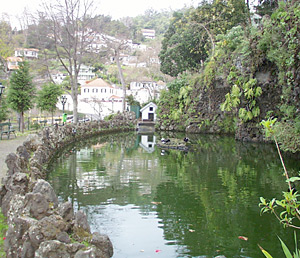
Located directly in the centre of Funchal city, and once home of a Franciscan
Convent, this is now a leisure area with trees offering shadow, a lake with
ducks and swans, a café, and an amphitheatre where entertaining and cultural
events often take place.
Describing this paradies in one word is not an easy task. Enchanting… is perhaps
the word that best describes Monte’s Municipal Garden.
Once the favourite holiday resort for aristocrats, it still brings back memories
of former times, through its flowers, ancient trees, the small river, and the
pebbly tracks.
Walking in Monte Municipal Garden makes me think of the people that probably
fell in love here, ladies with long dresses and umbrellas, and gentlemen with
walking-sticks
Nearby, you can see the Our Lady of Monte Church and its impressive steps. This
is where the exiled Emperor of Austria, Charles I, is buried.
![]()
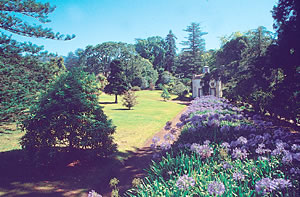
This property, now belonging to the Blandy family, has some of the most valuable
and rare exotic plants on the island.
The Quinta was acquired by the Blandy family in 1885 and successive generations
gave much work and devotion to the gardens.
The garden is a Mecca for Camellia lovers. The main flowering season happens
from November to April.
With beautiful gardens, a baroque chapel, and a magnificent manor house from the
18th century it also offers excellent views over Funchal city.


![]()
Covered with exotic
vegetation, Madeira is a fascinating Natural Ecological Reserve and two thirds
of the total area of the island is protected.
From the sea shore to the highest mountain peaks, there exist many wonderous
locations for you to enjoy and explore... find out more here.
![]()
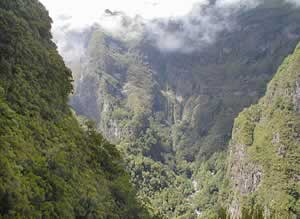
The natural forest of Madeira (the Laurissilva) occupies more than 20% of the
surface of the island, between the altitude of 300m and 1300m. You can find the
majority of it on the northern side of Madeira Island, due to the lower
temperatures and higher humidity. This is the biggest area of Laurissilva in the
world and is said to be the best preserved.
Its origins are to be found in the Tertiary Period, when the Laurissilva forest
covered a wide area of the Mediterranean. Now, it's limited to the
bio-geographical region of Macronesia that consists of Madeira, the Azores, the
Canaries and Cape Verde.
The word Laurissilva comes from the Latin 'silva', which means forest, and from
'Laurus' (lauraceae), family of the arboreal species that inhabits the forest.
Nowadays, it's classified as a 'UNESCO World Heritage' site.
This is the kind of forest where plant and animal species live together;
dependant on each other and on the surrounding environment.
Here you will find the four Lauraceae: the Ocotea foetens (Til), Laurus azorica
(Laurel), Persea indica (Brazilian mahogany) and Apollonias barbujana.
Apart from its dazzling beauty, this natural puzzle of shapes and shades of
green reveals all the dynamism that is typical of a balanced ecological system.
![]()
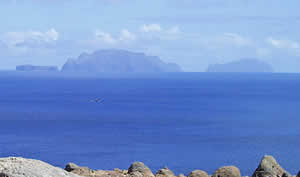
The Desertas are made up of three small islands - The Ilhéu Chão, Deserta Grande
and Bugio - all of volcanic origin.
To visit this natural reserve of the Desertas islands you will need permission.
This area became a protected area in 1990 and then became a natural reserve five
years later.
The islands are uninhabited due to the inhospitable conditions and lack of fresh
water.
Although initial protection scheme was for the benefit of the sea lions, it now
covers the complete eco-system of the islands. This is one of the last remaining
colonies of sea lions. Currently numbering around 23, the population is in
steady recovery.
The Desertas are made up of three small islands - The Ilhéu Chão, Deserta Grande
and Bugio - all of volcanic origin.
![]()
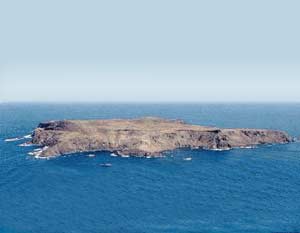
The Selvagens are composed of two small groups of islands, from which Selvagem
Grande, Selvagem Pequena and Ilhéu de Fora stand out.
The natural reserve was created in 1971 (one of the oldest in Portugal) for the
necessary protection of the marine avifauna.
Also, because of the unique conditions offered for the nesting of marine bird
species, these islands are well known as an 'ornithological paradise'.
![]()

The legislation that created Garajau's Natural Reserve, was made to protect a
very privileged area of Madeira's coast, in an effort to make it work as a
ecological nursery. This is the only exclusive marine reserve in the whole of
Portugal.
The reserve offers unique conditions as a protected area not only because of its
geographical location, but also for its biological diversity and extraordinary
clear crystal waters, which generate great scientific, recreational and tourist
interest.
Fishing is not allowed within the area and there are regular patrols from the
coast guard to ensure the reserve remains intact.
![]()

This is the most eastern peninsula of Madeira's Island, with length of 9 km
width of 2 km, including the two islands Ilhéu da Cevada and Ilhéu da Ponta de
São Lourenço.
It was declared a Natural Reserve in 1982 with the objective of preserving its
fauna, flora and geological heritage.
Ponta de São Lourenço's vegetation is very special and unique within Macronesia,
not because it's unchanged, but for the presence of important groups that are
virtually confined to this area.
Apart from the rich vegetation, this reserve is home to many bird species and
even sea lions that can occasionally be seen. The northern and southern coasts
differ very much from each other. The north coast is more dramatic and not
easily accessible by boat because it is more exposed to the winds and rough sea.
The south coast has seen less erosion and there exist numerous possibilities to
reach the shore by boat.
![]()

The local population are to thank for the introduction of the laws creating
Rocha do Navio's Natural Reserve in Santana. They noticed that the coastal area
was fast deteriorating because of illegal fishing with explosives - a practice
that caused severe damage to the marine life.
So, the idea of creating a multi-purpose nature reserve was born, with the aim
of protecting the marine fauna, preserving nature and enhancing the vast tourist
potential of the area.
This reserve is one of the most scenic beauty spots on the northern coast of the
Island and is located between Ponta de São Jorge and Ponta do Clérigo.

